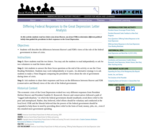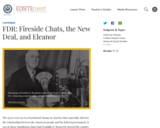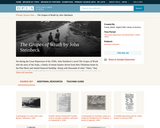
Despite their painful and long-lasting impact, American Indian boarding schools are an often neglected topic of study. In Module 3, students are introduced to this topic, with the goal of amplifying long unheard voices and better understanding this critical time in North American history. Students read Two Roads, the story of a thoughtful and independent boy named Cal and his father “Pop,” who live as traveling “knights of the road” after losing their farm during the Great Depression. Cal faces a critical question of identity when he learns from Pop that, after a lifetime of identifying as white, he is, in fact, part Creek Indian. Cal’s father shares this revelation days before enrolling Cal at the Challagi Indian Industrial School while he travels to Washington, DC alone. Cal challenges the expectations of the school’s administration, develops close friendships with other students, and questions, explores, evaluates, and affirms his varying identities. To deepen their understanding of American Indian boarding schools beyond a literary context, students also read a variety of supplemental texts, including informational reports and first-person accounts of life at American Indian boarding schools. Together, these texts further contextualize the anchor text and illustrate a wider range of experiences.
In Unit 1, students read excerpts of the initial chapters of the anchor text, which serves as a “hook,” inciting student interest in the history of American Indian boarding schools. Students then develop their knowledge of the historical context of the topic by reading related informational and narrative supplemental texts. Students consider the purported objectives of American Indian boarding schools and compare these against the often far darker experiences reported by the students who attended these schools. Students then return to the anchor text at chapter 9, better equipped to contextualize the experiences of Cal, Pop, and Cal’s friends. Unit 1 assessments gauge students’ abilities to read critically and independently for the author’s point of view and for background information on the topic.
In Unit 2, students finish reading the anchor text. They demonstrate continued development of reading skills, tracking character growth and central ideas and themes in the Mid-Unit 2 Assessment using a new excerpt from the text. An additional supplemental text is included in Unit 2 to support connections across the anchor text and the historical context. At the end of the novel, Cal faces the decision of returning to Challagi school or staying with his father in Washington, DC. Students convey Cal’s vacillating perspective toward this challenging question through a narrative letter to Possum, focusing on just one of the possible outcomes. This narrative assignment, which has the option of being assessed for its appropriate and accurate use of pronouns and sentence variety (a second assessment targeting these skills is also available), helps prepare students for the argument essay of Unit 3. Some of the evidence and reasoning incorporated into these student narratives will be repurposed and strengthened in an argument essay for the Mid-Unit 3 Assessment.
In Unit 3, students revisit the Painted Essay® structure as they construct their own argument essays. In those essays, they grapple with the question of whether Cal should return to the boarding school or remain with his father, whom he has run away to find. Students first collaboratively produce an argument piece using a similar prompt to further prepare for their independent argument essays. Module 3’s performance task presents the culmination of students’ learning about and reflections on the American Indian boarding schools through the production of an audio museum exhibit. Students select an excerpt from a text written by a survivor of American Indian boarding schools; they then write a preface to situate their text within a historical context and a reflection to convey the personal impact felt by their chosen text. Students record their preface, text, and reflection independently, and then use an audio recording application program to produce a product that will be featured at a listening station as part of the audio museum and can be widely shared to uplift the voices of American Indian boarding schools.
- Subject:
- English Language Arts
- Material Type:
- Module
- Unit of Study
- Provider:
- EL Education
- Date Added:
- 05/17/2024






